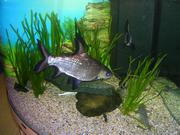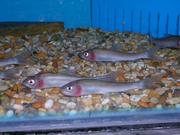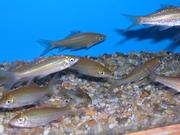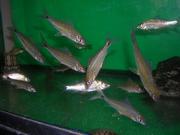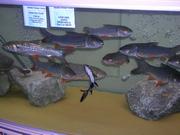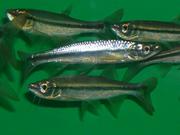Article categories:
Select a category below to view articles on each subject.
Search
Enter your keyword/s below to search :

Fish delivered straight to your door from Wildwoods
Hundreds of Species available today…
TFF Mailing List
Join the TFF mailing list today and we will email you with latest offers, news items and more.
The Bigger Shark-Minnows
The fish tropical fishkeepers call ‘sharks’ or ‘shark-minnows’ are in fact cyprinids of various kinds, mostly from Southeast Asia. The smaller ones are farmed in large numbers, with the Red-Tailed Black Shark, Epalzeorhynchus bicolor, and the Rainbow Shark, Epalzeorhynchos frenatum, being particularly popular. Larger species are traded as well, notably the Silver or Bala Shark Balantiocheilos melanopterus and several different Labeo species. These bigger sharks are challenging animals to keep, despite their wide availability, but in the right tank they can be very eye-catching. As their common names suggest, these sharks offer a combination of shape and graceful power that’s hard to beat.
General care
Without exception, shark-minnows need a spacious aquarium with plenty of swimming space and a good water current. Their streamlined shape reflects this, and even the smallest sharks like the Red-Tailed Black Shark aren’t going to work well in tanks smaller than 250 litres. Bigger species will need proportionally more room, and the sharks discussed in this article are suitable for tanks from 350 litres upwards.
Water chemistry requirements are typical of Southeast Asian fish, with soft, slightly acidic water conditions being preferred. But with that said, like many other cyprinids these are adaptable fish provided water quality is good, and moderately hard water doesn’t seem to cause them undue harm. Water temperature isn’t a major issue either, with most sharks being happy at the middling temperature values between 24-26 degrees C.
Diet
Shark-minnows tend to be omnivores, so a mixed diet that contains both animal and plant foods is required. Bloodworms, krill, and other small invertebrates are appreciated, as well as the usual flake and pellets. Among the possible green foods are cooked spinach, blanched lettuce, cooked peas, and of course algae. It should be noted that sharks can be quite hard on aquarium plants, and the bigger species may view them as little more than a buffet. If plants are being used in the shark aquarium, it’s best to choose robust varieties such as Java ferns, Anubias, Amazon swords, and the larger Vallisneria species.
Social behaviour
Although some species are peaceful, schooling fish others are notoriously territorial, at least under aquarium conditions. Some care needs to be taken to research a shark species before purchase, so that it is placed alongside the right sort of tankmates or kept in sufficient numbers for the species to feel settled. As a general rule, the territorial species are only aggressive towards other shark-like fish, and tend to ignore completely different fishes. There are exceptions though, and a few shark-minnows are so aggressive that their inclusion in community tanks is very risky indeed.
Silver or Bala Shark, Balantiocheilos melanopterus
This is the classic big shark, and a very popular aquarium fish. However, it is one of the biggest sharks in the trade, with an average length of around 25 cm when fully grown and a maximum length of 35 cm. On top of its sheer size, this very active and greedy species is also a schooling species that simply must be kept in groups of at least three specimens.
Given an aquarium of adequate size, realistically 375 litres or more, basic care isn’t actually all that difficult. Bala Sharks have proven to be adaptable fish, and though prone to jumping when alarmed, are otherwise good aquarium residents. This species is more predatory than herbivorous, and while some plant matter is consumed, small worms, shrimps and other invertebrates are particularly appreciated.
Labeo spp.
The genus Labeo presents a mixed bag of fairly large species, some of which are reasonably easy-going while others are notoriously grumpy. At the meaner end of the spectrum is the Black Shark, Labeo chrysophekadion. Youngsters around the 5 cm mark are frequently sold, but buyers should be aware that this species can get to as much as 30 cm in length and becomes increasingly intolerant of similar-looking fish the older it gets. Obviously a very big aquarium will be needed for this species, at least 375 litres, but the Black Shark is also notoriously sensitive to less-than-perfect water quality, so filtration and regular water changes are critical.
Labeo boga is known as the Violet Gilled Shark because of its peculiar appearance. It is basically colourless except for a vague pinkish-grey tint, but its gills are clearly visible through its transparent gill covers, resulting is a very distinctive looking fish. Newly imported specimens are often very underweight, but given a good varied diet quickly fatten up. Healthy specimens are very active, somewhat intolerant of one another, but work well alongside dissimilar fish. Maximum length is around 30 cm.
The Harlequin Shark Labeo variegatus is an old favourite, and while it isn’t commonly traded, it does appear on a regular basis in shipments from Zaire. As its name suggests, this species is quite strikingly coloured, with mottled brown on its body and orangey fins. Size, diet and basic care are much like the other Labeo already mentioned.
Labeobarbus spp.
At least three species in this genus are imported, the Bornean Eye-Spot Shark Labiobarbus ocellatus, the Festive Apollo Shark Labeobarbus festivus, and the Siamese Arrow Shark Labiobarbus siamensis. All are of medium size, getting to about 20-25 cm in length, and appear to be peaceful, schooling fish. Kept in groups of six or more specmens they largely keep to themselves, making them excellent dither fish for big catfish and loaches, but they are predatory towards very small fish and may nip the fins of slow-moving tankmates. Labeobarbus are strong swimmers and need a long tank with a strong current and plenty of oxygen. Given their size and habits, these are fish for tanks 350 litres or bigger. They can be shy initially after import, and may disdain flake and pellet foods. Wet-frozen insect larvae are welcomed though, as are suitable soft plant foods like lettuce.
Apollo Sharks, Luciosoma setigerum and Luciosoma trinema
The two species are very similar-looking. Luciosoma setigerum is more slender and has a slightly upturned snout. It is marked with a row of small circular black spots along the midline of the flank. On the back half of the body, these spots merge to form a continuous band. A distinctive coppery spot is seen on the nose, just in front of the eyes. Luciosoma trinema is stockier, and the snout is not upturned. The black spots on the midline of the flank are larger and commonly vertically elongate ovals or short bars on the front half of the body. These spots do not tend to form a continuous band on the back half of the body.
In both cases these fish get to about 20-25 cm in length and need to be kept in groups. They appreciate lots of open swimming space at the top of the tank, as well as a decent current. Water chemistry isn’t critical, but water quality needs to be excellent, and there should also be lots of oxygen. They are jumpers, but not especially shy or nervous. Apollo Sharks are strongly predatory, but work well alongside any fish too large to swallow whole. They are superb companions for South American cichlids and other denizens of the middle and bottom layers of the aquarium. Feeding is unproblematic, as they happily take pellet foods as well as the usual live and frozen foods. A school of healthy specimens looks spectacular, but given their size and activity, these are very much fish for the bigger aquarium, 375 litres or more.
Other fish articles:
Other fish articles you may be interested in are listed below, click an article for full details.
-
FISH ARTICLE
-
FISH ARTICLE
-
FISH ARTICLE
-
FISH ARTICLE






